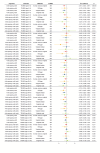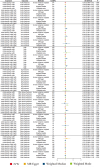Causal Association Between Genetically Predicted Ankle Spacing Width and Risk of Age-Related Bone Mineral Density
- PMID: 40640400
- PMCID: PMC12246474
- DOI: 10.1038/s41598-025-09765-7
Causal Association Between Genetically Predicted Ankle Spacing Width and Risk of Age-Related Bone Mineral Density
Abstract
While observational studies suggest associations between ankle spacing width (ASW, defined as the horizontal distance between the medial malleoli under weight-bearing conditions) and osteoporosis (OP), fractures, and falls, causal evidence remains limited. This gap hinders the translation of ASW measurements into clinical risk stratification tools. This study aimed to investigate the causal relationships between ASW indicators and site-/age-specific bone mineral density (BMD), bone fracture and fall risks. Genetic exposure data for ASW indicators were retrieved from the MRC-IEU datasets, and the outcome data were all derived from the Genetic Factors for Osteoporosis Consortium (GEFO). Genome-wide associations of single nucleotides polymorphisms (SNPs) were served as instrumental variables (IVs) to infer causal effects using two-sample mendelian randomization (TSMR) and multivariable mendelian randomization (MVMR) analyses. The results of sites-specific TSMR analysis revealed that per unit increase in ASW (including left and right) were causally associated with lower estimated from quantitative heel ultrasounds BMD (eBMD, reflecting calcaneal bone density) and total-body BMD (TB-BMD, assessed via DEXA scans), with pronounced effects in individuals aged over 60 years. Age-stratified analyses revealed no significant associations between ASW and TB-BMD in younger age groups (age ≤ 15, 15 < age ≤ 30, 30 < age ≤ 45, 45 < age ≤ 60) or site-specific fractures/falls. MVMR adjustment for BMI, smoking, and alcohol consumption confirmed persistent causal associations between ASW and reduced eBMD and TB-BMD, particularly for TB-BMD in individuals aged over 60 years. Our study provides evidence that genetically predicted ASW is associated with reduced eBMD and TB-BMD, and a causal association between ASW and TB-BMD (aged over 60), suggesting ASW as a potential auxiliary biomarker for monitoring age-dependent bone loss.
Keywords: Ankle spacing width; Bone mineral density; Mendelian randomization; Osteoporosis.
© 2025. The Author(s).
Conflict of interest statement
Declarations. Competing interests: The authors declare no competing interests.
Figures






Similar articles
-
Associations of Anthropometric Indicators with Bone Mineral Density and the Risk of Bone Fractures and Falls: A Large-Scale Genetic Correlation Study.Endocr Metab Immune Disord Drug Targets. 2025 Jul 18. doi: 10.2174/0118715303369995250702111723. Online ahead of print. Endocr Metab Immune Disord Drug Targets. 2025. PMID: 40692145
-
Causal relationship between tea intake and bone mineral density at different ages ̶ A Mendelian randomization study.Nutr Hosp. 2025 Jun 19;43(3):544-554. doi: 10.20960/nh.05661. Nutr Hosp. 2025. PMID: 40195739 English.
-
Causal effects of lipidomics and osteoporosis-related traits: a Mendelian randomization study.Clin Rheumatol. 2025 Jul;44(7):3013-3024. doi: 10.1007/s10067-025-07532-7. Epub 2025 Jun 11. Clin Rheumatol. 2025. PMID: 40494949
-
Effectiveness and safety of vitamin D in relation to bone health.Evid Rep Technol Assess (Full Rep). 2007 Aug;(158):1-235. Evid Rep Technol Assess (Full Rep). 2007. PMID: 18088161 Free PMC article.
-
Calcium and vitamin D for increasing bone mineral density in premenopausal women.Cochrane Database Syst Rev. 2023 Jan 27;1(1):CD012664. doi: 10.1002/14651858.CD012664.pub2. Cochrane Database Syst Rev. 2023. PMID: 36705288 Free PMC article.
References
-
- Balzini, L. et al. Clinical characteristics of flexed posture in elderly women. J. Am. Geriatr. Soc.51, 1419–1426 (2003). - PubMed
MeSH terms
Grants and funding
LinkOut - more resources
Full Text Sources
Medical
Miscellaneous

